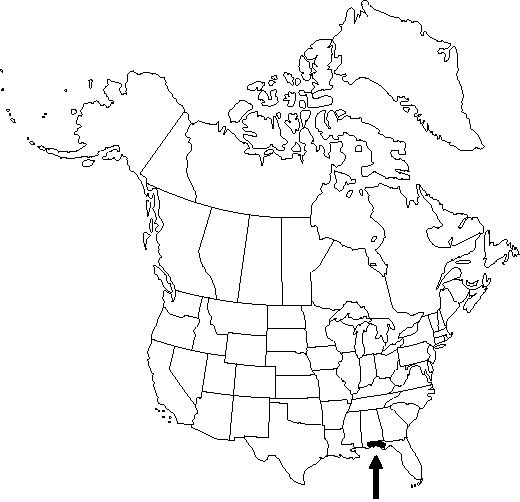Difference between revisions of "Magnolia ashei"
Rhodora 28: 35. 1926.
FNA>Volume Importer |
FNA>Volume Importer |
||
| Line 20: | Line 20: | ||
|basionyms= | |basionyms= | ||
|synonyms={{Treatment/ID/Synonym | |synonyms={{Treatment/ID/Synonym | ||
| − | |name= | + | |name=Magnolia macrophylla subsp. ashei |
|authority=(Weatherby) Spongberg | |authority=(Weatherby) Spongberg | ||
| − | }}{{Treatment/ID/Synonym | + | }} {{Treatment/ID/Synonym |
| − | |name= | + | |name=Magnolia macrophylla var. ashei |
|authority=(Weatherby) D.L. Johnson | |authority=(Weatherby) D.L. Johnson | ||
}} | }} | ||
| Line 41: | Line 41: | ||
|distribution=Fla. | |distribution=Fla. | ||
|discussion=<p>Of conservation concern.</p><!-- | |discussion=<p>Of conservation concern.</p><!-- | ||
| − | --><p>Magnolia ashei, the rarest species of Magnolia in the flora, is limited to six counties in the Florida panhandle; it is in danger of extirpation because of habitat disturbance. Magnolia ashei differs from M. macrophylla in being a smaller, often multitrunked tree with smaller leaves, fewer stamens and pistils, smaller seeds, smaller stipules, filiform trichomes, and smaller, nearly glabrous, cylindric follicetums. The flowers are often borne in pairs. Magnolia ashei flowers at an early age (three to four years from seed); it is a desirable small tree in cultivation.</p> | + | --><p><i>Magnolia ashei</i>, the rarest species of <i>Magnolia</i> in the flora, is limited to six counties in the Florida panhandle; it is in danger of extirpation because of habitat disturbance. <i>Magnolia ashei</i> differs from <i>M. macrophylla</i> in being a smaller, often multitrunked tree with smaller leaves, fewer stamens and pistils, smaller seeds, smaller stipules, filiform trichomes, and smaller, nearly glabrous, cylindric follicetums. The flowers are often borne in pairs. <i>Magnolia ashei</i> flowers at an early age (three to four years from seed); it is a desirable small tree in cultivation.</p> |
|tables= | |tables= | ||
|references= | |references= | ||
| Line 54: | Line 54: | ||
|rank=species | |rank=species | ||
|parent rank=genus | |parent rank=genus | ||
| − | |synonyms= | + | |synonyms=Magnolia macrophylla subsp. ashei;Magnolia macrophylla var. ashei |
|basionyms= | |basionyms= | ||
|family=Magnoliaceae | |family=Magnoliaceae | ||
| Line 65: | Line 65: | ||
|publication year=1926 | |publication year=1926 | ||
|special status=Conservation concern;Endemic;Selected by author to be illustrated | |special status=Conservation concern;Endemic;Selected by author to be illustrated | ||
| − | |source xml=https://jpend@bitbucket.org/aafc-mbb/fna-data-curation.git/src/ | + | |source xml=https://jpend@bitbucket.org/aafc-mbb/fna-data-curation.git/src/8f726806613d60c220dc4493de13607dd3150896/coarse_grained_fna_xml/V3/V3_625.xml |
|genus=Magnolia | |genus=Magnolia | ||
|species=Magnolia ashei | |species=Magnolia ashei | ||
Revision as of 18:18, 18 September 2019
Trees, deciduous, often multitrunked, to 10(-12) m. Bark dark gray, smooth. Pith homogeneous. Twigs and foliar buds silky-pubescent. Leaves crowded in terminal whorl-like clusters; stipules 6-8 × 3-4 cm, abaxially pilose, glandular. Leaf blade broadly elliptic to obovate-oblong, (17-)25-46(-56) × (10-)15-30(-40) cm, base truncate to deeply cordate or auriculate, apex acute to short-acuminate; surfaces abaxially chalky white or pale green to glaucous, pilose, adaxially deep green, glabrous. Flowers solitary or often in pairs on adjacent twigs, fragrant, 15-38(-50) cm across; spathaceous bracts 2, outer bract abaxially rusty gray, inner bract glabrous; tepals creamy white, glandular, innermost whorl purple-blotched at base, outermost segments strongly reflexed, greenish; stamens 170-350, 13-20 mm; filaments white; pistils 20-50. Follicetums cylindric to nearly ovoid, 2.5-6.5 × 1.5-4 cm; follicles short-beaked, distally appressed silky-pubescent. Seeds lenticular to somewhat globose, 8-10 mm, aril orange-red. 2n=38.
Phenology: Flowering spring.
Habitat: Woodlands, ravines, and bluffs, coastal plain
Elevation: 0-50m
Discussion
Of conservation concern.
Magnolia ashei, the rarest species of Magnolia in the flora, is limited to six counties in the Florida panhandle; it is in danger of extirpation because of habitat disturbance. Magnolia ashei differs from M. macrophylla in being a smaller, often multitrunked tree with smaller leaves, fewer stamens and pistils, smaller seeds, smaller stipules, filiform trichomes, and smaller, nearly glabrous, cylindric follicetums. The flowers are often borne in pairs. Magnolia ashei flowers at an early age (three to four years from seed); it is a desirable small tree in cultivation.
Selected References
None.

